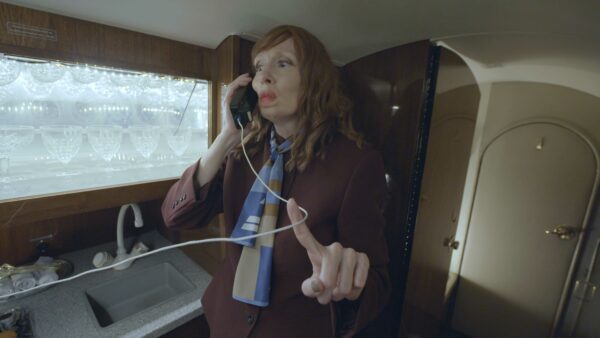Jordan Strafer’s films look as if they arrived straight from the eighties and early nineties. In that era, indie rock and grunge bandleaders sorted humanity into lovable refuse, themselves included, on one side, and corporate monsters, the elders of American society, their tans invincible and jaws firmly clenched, on the other. Anyone nursing a vinyl copy of Sebadoh’s Bakesale and habitually rewatching early Harmony Korine films will quickly recognize Strafer’s visuals. This reliance on the global perestroika aesthetic might seem weird for an artist born a year after the fall of the Berlin Wall, but as a self-professed “child of YouTube,” Strafer is generationally positioned to feel nostalgia for the era. Thus, some of her videos look as if they were shot on a handheld VHS camera, with murky depth of field and reduced frame stabilization. These stylistic choices, however, do not make Strafer’s work a pastiche of a bygone mass culture. It’s more of a Freudian media archeology, where specific remembrances lead to a rabbit hole of despairing self-reflection.
There’s an eternal teenager at the heart of Strafer’s three films, always frustrated, preyed upon, and mistreated by the older people. The narrative is vaguely that of the loss of innocence, directly addressed in SOS (2021), where a doll, stranded on a snowy beach, observes an airplane sky-writing the words “STUPID SLUT” on a clear blue sky. The teenager takes a lot of shit from the powers that be, and, incidentally, excrement plays a vital role in two of the films, a visual analogy of a potty mouth. To cope with all the guignol, the protagonist often turns to body dissociation. “I am doll parts, doll lips, doll heart,” intoned Courtney Love on Hole’s “Doll Parts” from 1994; many of Strafer’s emotional punches follow along these lines, employing ready-made and created puppets to get her points across. One is reminded of the practice of child psychologists that invite their patients to deal with trauma by showing abuse on and through a doll. A lot of what’s going on in Strafer’s films can be called psychodrama (Ingmar Bergman’s Persona was an early influence), and it’s mainly the “drama” part that is unfolding before us.

Jordan Strafer, “PEP (Process Entanglement Procedure),” 2019, two-channel HD video: color and sound, 15 minutes. Courtesy of the artist
The artist is open to placing her work in her own biography, but it’s less of a staged recreation and more of a “re-feeling,” with extra details, excessive violence, and body horror dream sequences. In PEP (2019), Jordan’s character expires in a ritual murder by two masked men who kiss over her dead body, sprayed on a rock in a snowy wood. (Her father is married to a man). Their masks remind one of another nineties favorite, Kathryn Bigelow’s Point Break, where a team of surfer misfits robs a bank, each dressed as American presidents.
In one memorable scene from Strafer’s film, we see the protagonist naked from the waist down, with “NO MOMMY” written on her butt cheeks. In another, she, as Barbie, is questioned in court, also by men. PEP’s narrative is polluted by patriarchy in all of its forms, including the queer kind, and for the woman there is no escape — neither from knives nor from aggressive questioning. It’s tempting to think of PEP as a kind of indie Barbie movie that expands on the toy’s ambiguity as both a transitional object and stand-in for the human owner in a way that’s more realistic than the Hollywood production.

Jordan Strafer, “PEAK HEAVEN LOVE FOREVER,” 2022, two-channel HD video: color and sound, 19 minutes. Courtesy of the artist.
PEAK HEAVEN LOVE FOREVER (2022) gives its main character some agency, along with a progressing skin disease. The film is loosely based on an actual, distressing experience of evacuating Strafer’s ill father to the U.S. in a private medical airplane. Unlike real life, the video ends in a magenta-colored murder-suicide. Characters switch from dolls to humans and back again, with no discernible difference in terms of plot, but with the unrelenting and captivating rhythm of a music video. At some point in the middle, PEAK turns into exactly that, when the plane’s interior transforms into a variety show stage set and the cast mimes The Mamas & The Papas classic “Dedicated to the One I Love.” One of the passengers is a “Florida man,” complete with an intense spray tan, who looks like a conflation of a recent batch of rightwing politicians. No direct nods to recent events are present, however, Strafer’s dreamworld situates itself squarely in the U.S. before Trump, 9/11, and other instances of the nationwide loss of innocence.

Jordan Strafer, “PEAK HEAVEN LOVE FOREVER,” 2022, two-channel HD video: color and sound, 19 minutes. Courtesy of the artist.
In Houston, Trilogy looks exciting, just by virtue of feeling more “now” than most of what’s on and also by relating to a recognizable media landscape. The art that is on show in the city as a whole was either made before the invention of the Internet or actively ignores the significant changes to the visual language that browsing has brought in. Strafer’s videos, by contrast, reflect the increasing unreliability of the narrator and the random salad of effects that a social media feed can make us feel. In a placid lake of Modernism, this show is a breath of fresh wind.
Jordan Strafer: Trilogy is on view at Contemporary Arts Museum Houston, through November 26, 2023.



